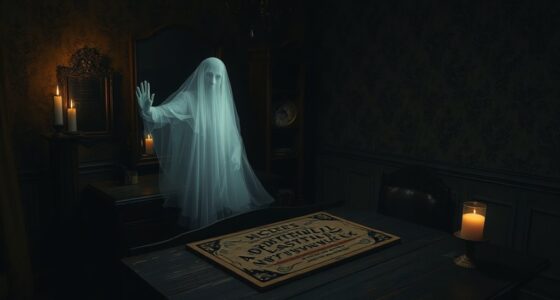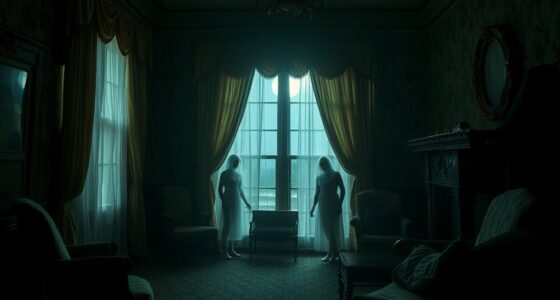A haunting involves spirits lingering in a specific location or object, often manifesting through paranormal activity. In contrast, a curse represents a malevolent force that negatively affects a person or place due to its dark history or intentional acts. While haunted spaces can be cleansed to restore peace, cursed locations maintain their sinister aura. Understanding these differences can help you navigate the complexities of the supernatural. There’s much more to uncover about these intriguing phenomena.
Key Takeaways
- Hauntings involve the presence of spirits manifesting in a location, while curses are malevolent forces tied to specific objects or places.
- Haunted houses can return to normal after expelling spirits, whereas cursed houses retain their malevolent nature due to dark histories.
- Architectural features in haunted houses enhance eerie experiences, while cursed houses are designed to embody evil.
- Emotional trauma influences hauntings, with spirits reflecting past occupants’ experiences, while curses create a symbiotic relationship with inhabitants’ psychic energy.
- Cultural beliefs shape interpretations of hauntings as spirits and curses as intentional malice, influencing modern cleansing rituals.
Defining Hauntings and Curses
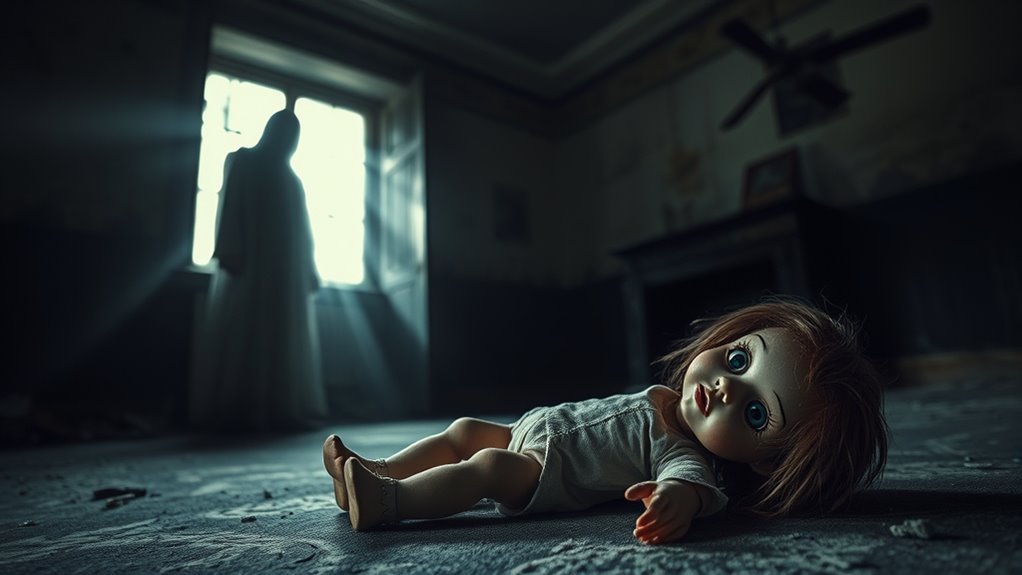
When you explore the concepts of hauntings and curses, you’ll find that they stem from very different sources.
Haunted objects often carry the presence of ghosts or spirits from the Astral Plane, manifesting disturbances that feel external. In contrast, curses are inherent malevolent forces tied to an object or location, creating misfortune regardless of supernatural involvement.
Haunted objects house external spirits, while curses embody malevolent forces, ensuring misfortune persists regardless of supernatural influence.
While a haunted house can return to normal once the unwanted spirits are expelled, a cursed house retains its malevolent nature, reflecting the dark history or intentional acts behind it.
Think of the infamous Annabelle doll as a cursed object, bringing bad luck to its owners, compared to locations like Shirley Jackson’s “The Haunting of Hill House,” where the spirits create haunting experiences.
The Nature of Haunted Houses
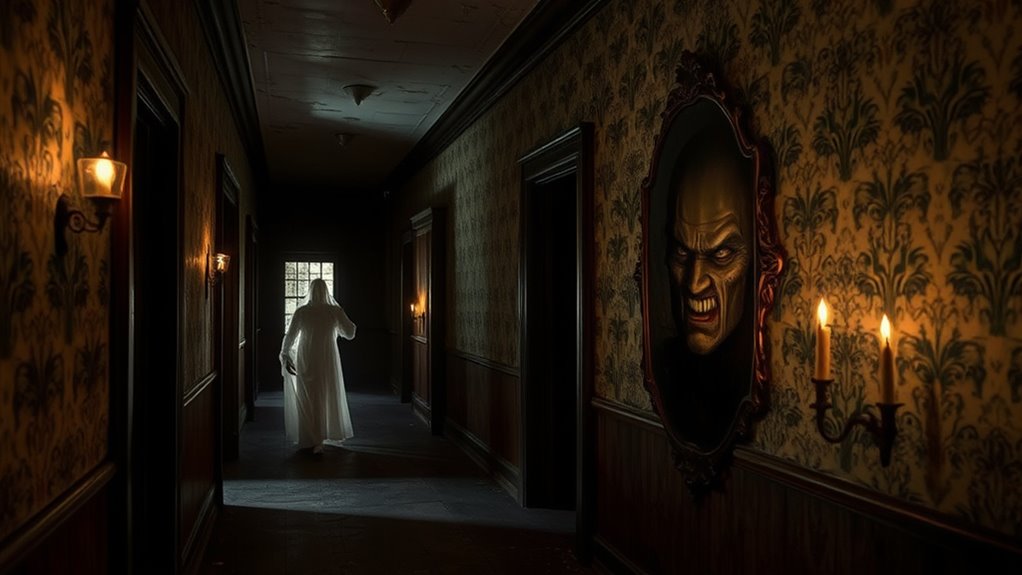
Haunted houses captivate our imagination, as they often hold the lingering presence of spirits or entities that create an unsettling atmosphere.
These spaces are characterized by paranormal entities that manifest externally, leaving occupants feeling disoriented and fearful. Architectural features, like distortions and irregular shapes, enhance this eerie experience, making it hard to shake off the feeling of unease.
Often, the energy absorbed from inhabitants, especially those with trauma, attracts these entities, turning the house into a hotspot for hauntings.
Unlike cursed houses, which maintain a malevolent essence regardless of external influences, haunted houses can be cleansed.
Once the undesirable beings are removed, you can restore the home to its former state, freeing it from the haunting presence.
The Characteristics of Cursed Houses
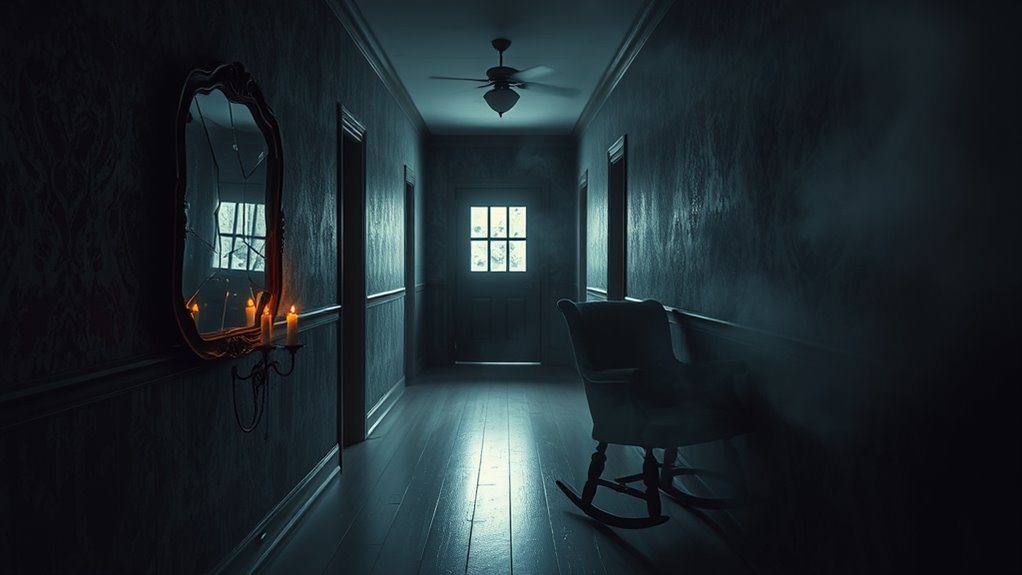
When you step into a cursed house, you can immediately sense its malevolence, crafted into the very architecture itself.
The irregular shapes and angles create an unsettling atmosphere that affects your thoughts and feelings.
As you live there, the house seems to feed off your psychic energy, amplifying any trauma and altering your memories in unsettling ways.
Structural Malevolence Manifestation
Cursed Houses inherently possess a structure that radiates malevolent power, affecting the behavior and mental state of anyone who dwells within. This architectural design amplifies the house’s sinister essence, making it a constant source of unease.
- Distorted shapes and angles create disorientation.
- The history of trauma intertwines with the architecture.
- Unlike haunted houses, these maintain their evil nature.
- They form a symbiotic relationship with the inhabitants’ energy.
As you navigate through these cursed houses, you’ll feel the oppressive weight of their malevolent influence. The very walls seem to feed off past violence, perpetuating a cycle of negativity.
The structure itself becomes a vessel of darkness, binding you to its eerie legacy.
Impact on Inhabitants’ Psyche
The oppressive atmosphere of a cursed house can deeply affect your psyche, leading to unsettling changes in thoughts and emotions. Unlike haunted houses, where ghostly manifestations are prevalent, cursed houses create a toxic environment that magnifies your traumas and emotional distress.
The disorienting architecture, with its irregular shapes, further complicates your psychological state, making you feel lost or uneasy. You might start recalling memories from previous occupants, forging a disturbing connection between the house’s history and your own mind.
This persistent malevolent energy can trap you in repetitive patterns of trauma and misfortune, intensifying your psychological struggles. Living in such a space blurs the lines between your thoughts and the house’s dark essence, leaving a lasting impact on your mental well-being.
Architectural Influences on Hauntings and Curses
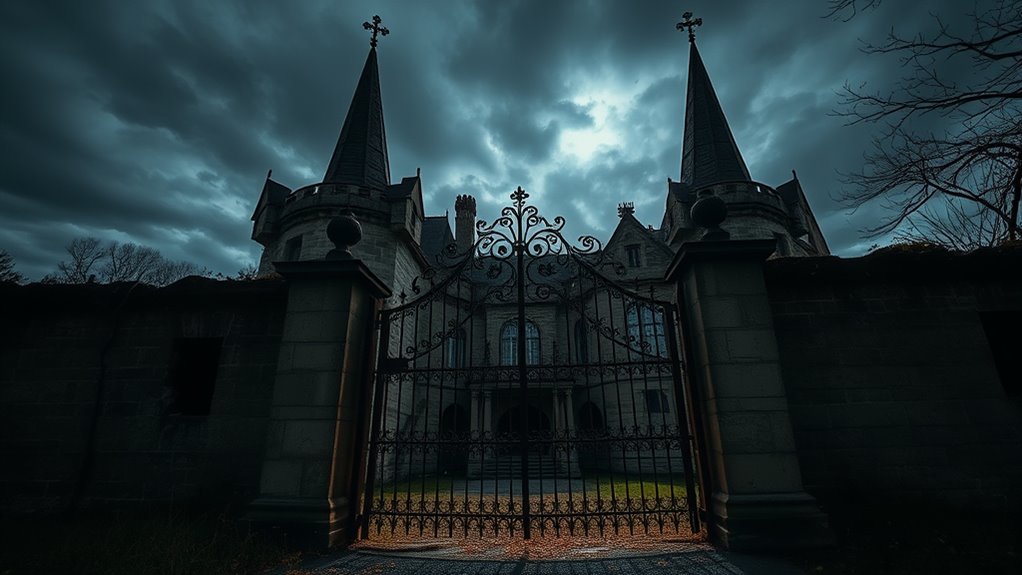
As you explore the world of hauntings and curses, notice how architectural features can shape your experience.
Irregular shapes and distortions in a building can create disorientation, amplifying the unsettling energy that may lead to ghostly encounters.
Additionally, the history of a structure often reveals the malevolent events that contribute to its cursed nature, making its design even more significant.
Structural Disorientation and Trauma
When you step into a house with irregular shapes and angles, you might feel an unsettling disorientation that goes beyond mere architecture. This structural disorientation can trigger psychological trauma, linking your emotional state to the house itself.
- Cursed houses often embody inherent evil through their design.
- Haunted houses absorb the energy of their inhabitants, amplifying feelings of dread.
- The geometry of a space can evoke an overwhelming sense of unease.
- Distorted architecture creates a cycle of trauma, reinforcing the house’s cursed status.
Inhabiting such spaces may attract those with unresolved issues, making the symbiotic relationship between the structure and its occupants even more pronounced.
It’s a chilling reminder of how architecture can influence our psyche.
Architectural Distortions and Energy
Architectural distortions play an essential role in shaping the energy dynamics within both haunted and cursed houses. Irregular shapes and angles create disorienting spaces, enhancing the supernatural experience and facilitating energy absorption from inhabitants.
In haunted houses, this energy absorption often attracts individuals with trauma, amplifying their emotional states. Conversely, cursed houses possess structures that inherently manifest evil power, forging a symbiotic relationship with the psychic energy of occupants.
The unique geometry of a dwelling can lead to unsettling spatial experiences, much like those depicted in Shirley Jackson’s “The Haunting of Hill House.” Ultimately, the physical layout and design greatly influence your psychological state, deepening the connection between architecture and the haunting or curse you might experience.
Historic Influence on Evil
The historical context of a building greatly shapes its association with evil, influencing whether it becomes a site of haunting or curse. Architectural features contribute considerably to this classification, revealing the evil nature embedded within structures.
Consider these aspects:
- Cursed houses often have irregular shapes that disorient occupants.
- Haunted houses, like Hill House, absorb energy, attracting unresolved trauma.
- The history of a building defines its experience; cursed houses maintain their malevolence.
- Literary figures, such as Lovecraft, illustrate how architectural geometry enhances the sense of evil.
These factors create a symbiotic relationship between the structure and its inhabitants, turning them into haunted objects or cursed sites, and making the distinction between a haunting and a curse all the more complex.
The Role of Trauma in Haunted and Cursed Spaces
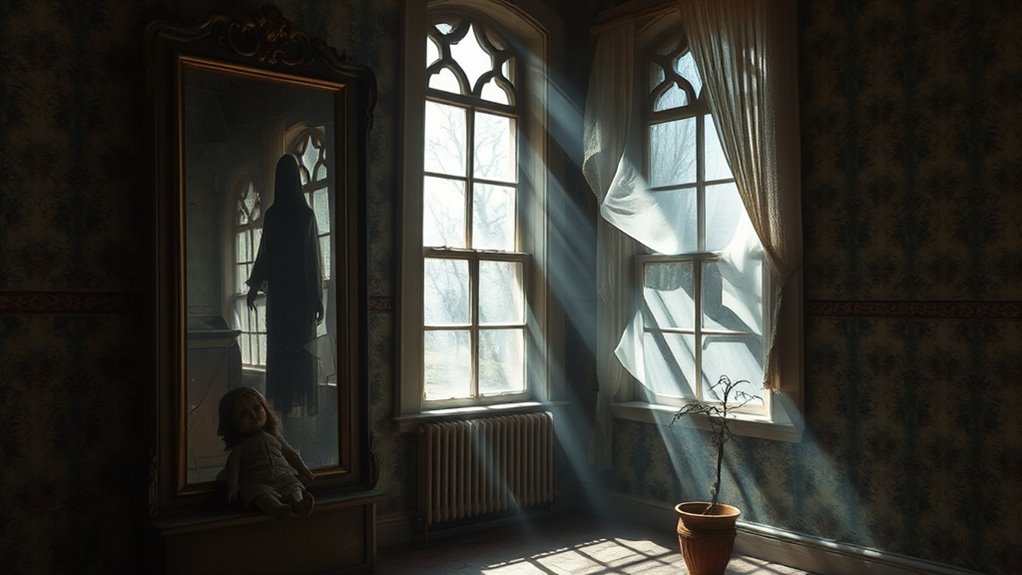
Trauma plays a crucial role in shaping the experiences within haunted and cursed spaces, as these environments often reflect the emotional weight carried by their inhabitants.
Trauma significantly influences experiences in haunted and cursed spaces, mirroring the emotional burdens of those who dwell within.
In haunted houses, you might notice ghostly manifestations tied to the unresolved traumas of previous occupants, creating a chilling atmosphere.
Cursed spaces, however, form a symbiotic relationship with your psychic energy, exacerbating traumas and leading to patterns of distress.
The architectural features of cursed houses, with their irregular shapes, can amplify your feelings of disorientation and unease.
Both types of spaces highlight the significance of past tragedies, with cursed environments maintaining their malevolence, perpetuating cycles of trauma that affect your thoughts and behaviors in disturbing ways.
Emotional Connections to Haunted and Cursed Objects

Haunted and cursed objects often carry a weight of emotional significance that resonates deeply with those who encounter them. You might find yourself forming strong emotional connections to these items, drawn in by their tragic histories and the stories they tell.
Consider how:
- Haunted objects can feel like a bridge to deceased loved ones, fostering a bond that defies death.
- Cursed objects evoke fear and anxiety, making you cautious and respectful of their power.
- Naming these items can deepen your attachment, as seen in enthralling narratives.
- Cultural narratives shape your understanding of luck and misfortune, influencing how you perceive these items.
Ultimately, your emotional journey with haunted and cursed objects reveals much about your own beliefs and experiences.
Cultural Perspectives on Hauntings and Curses
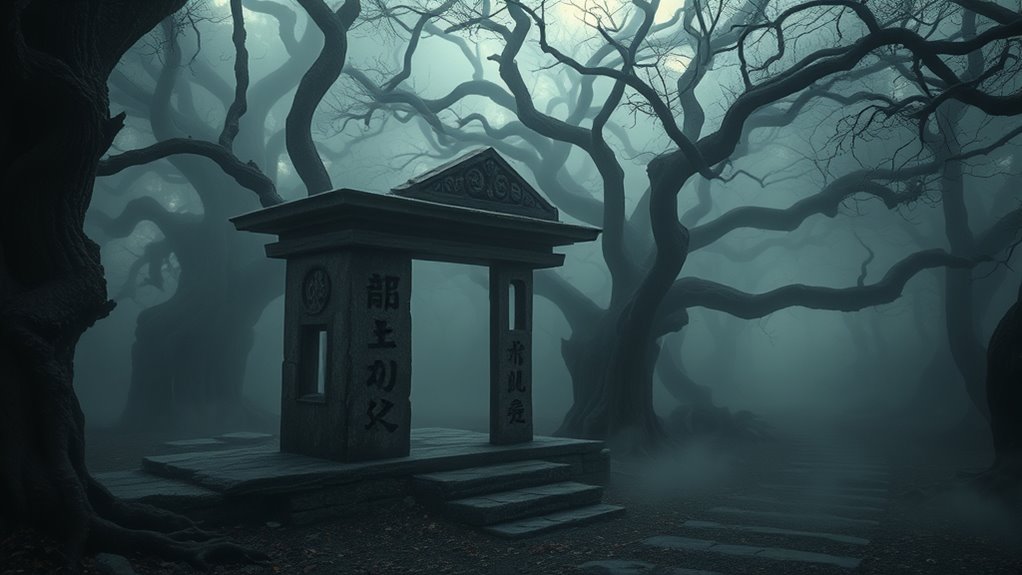
When you explore cultural perspectives on hauntings and curses, you’ll find that historical beliefs shape how different societies interpret these phenomena.
Many cultures view hauntings as spirits tied to their past, while curses are often seen as intentional acts of malice.
Understanding these interpretations helps you appreciate the spiritual significance of objects and the narratives that surround them.
Historical Beliefs and Practices
Throughout history, cultures around the world have developed distinct beliefs and practices surrounding hauntings and curses, reflecting their unique perspectives on the supernatural. You might find that:
- Ancient Egyptians inscribed curses on tombs to deter intruders, while hauntings stemmed from restless spirits.
- Indigenous cultures viewed curses as punishments for violating sacred laws, contrasting with hauntings as ancestral guidance.
- In Jewish folklore, dybbuks represent spirits possessing individuals due to unfulfilled obligations, emphasizing intent behind hauntings and curses.
- Modern rituals aim to cleanse spaces of hauntings or break curses, showcasing evolving responses to these phenomena.
These historical beliefs reveal a rich tapestry of how different cultures interpret cursed objects and the lingering presence of spirits, creating unique narratives around hauntings and curses.
Cultural Interpretations of Evil
Cultural interpretations of evil shape how societies perceive hauntings and curses, often reflecting their unique histories and values. You’ll find that some cultures see hauntings as expressions of unresolved trauma, while curses are viewed as deliberate acts of malevolence. For instance, Islamic tradition links hauntings to jinn inhabiting spaces, whereas curses stem from human actions. In Jewish folklore, dybbuks possess the living, emphasizing unresolved pasts.
| Cultural Context | Hauntings | Curses |
|---|---|---|
| Islamic | Jinn causing disturbances | Human actions invoking punishment |
| Jewish | Dybbuks possessing individuals | Witchcraft leading to misfortune |
| General Beliefs | Spirits reflecting trauma | Supernatural forces causing harm |
| Literature/Media | Metaphors for psychological conflict | Objects like the Dybbuk Box |
| Global Perspectives | Varied interpretations | Intention behind the curse |
Spiritual Significance of Objects
Objects often hold deep spiritual significance, especially in the context of hauntings and curses, as they can embody the stories and energies of their past. Understanding these meanings can enhance your perception of both cursed objects and haunted artifacts.
Consider these points:
- Cursed objects often link to tragic histories or intentional curses, resulting in misfortune.
- Haunted objects may house spirits, but they don’t always bring harm.
- Cultural beliefs shape interpretations, like jinn in Islam or dybbuks in Jewish folklore.
- The fascination with cursed objects, often displayed in museums, reflects their profound spiritual significance.
Recognizing the diverse cultural perspectives on these objects can deepen your appreciation for their historical and spiritual narratives, influencing how you engage with them.
Infamous Examples of Haunted and Cursed Items
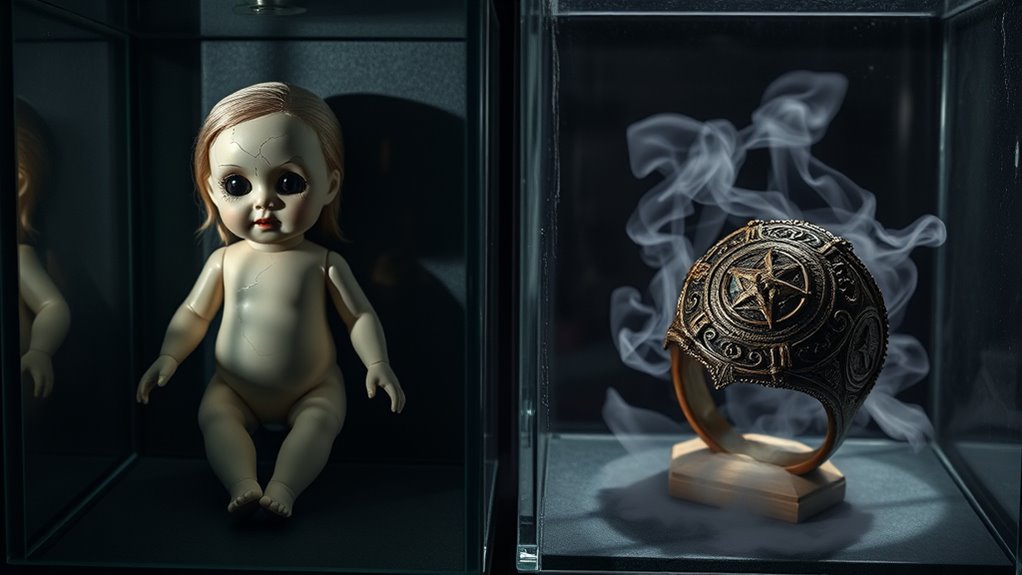
Haunted and cursed items have fascinated people for centuries, sparking tales of eerie encounters and misfortunes. Here are some infamous examples that highlight the chilling nature of these objects:
| Haunted Items | Cursed Objects |
|---|---|
| Annabelle the Doll | The Dybbuk Box |
| Robert the Doll | The Basano Vase |
| The Hope Diamond |
Annabelle, housed in the Warren Occult Museum, is linked to physical attacks. The Dybbuk Box contains a restless spirit, causing strange occurrences. Robert the Doll moves on its own, often bringing accidents to mockers. Finally, the Hope Diamond’s tragic history makes it one of the most notorious cursed objects, believed to bring calamity to its owners.
How to Identify a Cursed Object
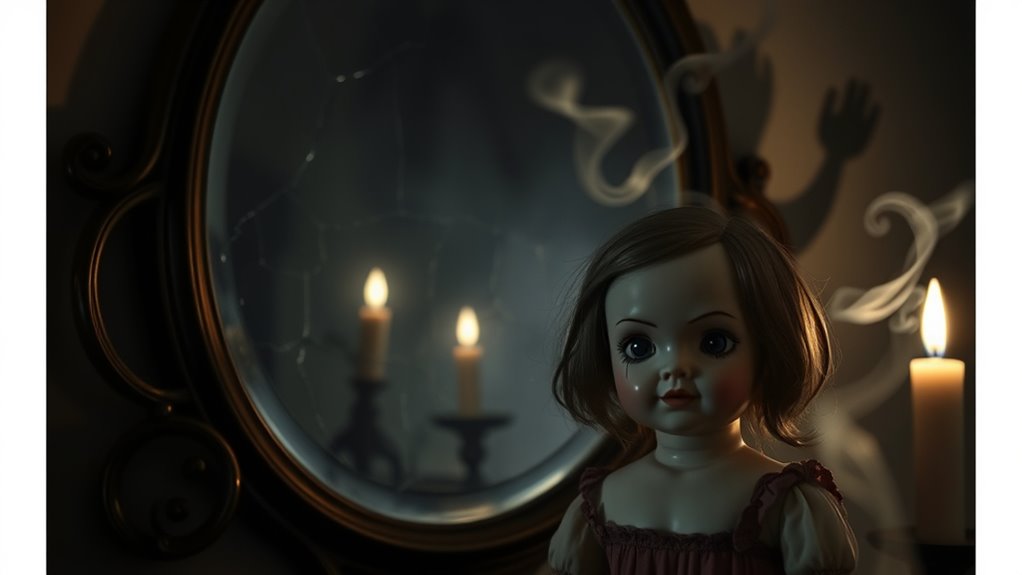
How can you tell if something you own is cursed? Cursed objects often bring tangible suffering or misfortune, so look for these signs:
- Persistent bad luck or financial loss after acquiring the item
- Unexplained health issues affecting you or those close to you
- Strong feelings of unease or dread when you handle the object
- A troubling history tied to death, tragedy, or rituals
Unlike haunted objects, which may only evoke unsettling feelings, cursed objects seem to actively inflict harm.
Researching the backstory of an item is vital, as many cursed items have documented histories that reveal their malevolent nature.
If you notice these signs, it might be time to reconsider your relationship with that object.
The Impact of Hauntings and Curses in Popular Culture
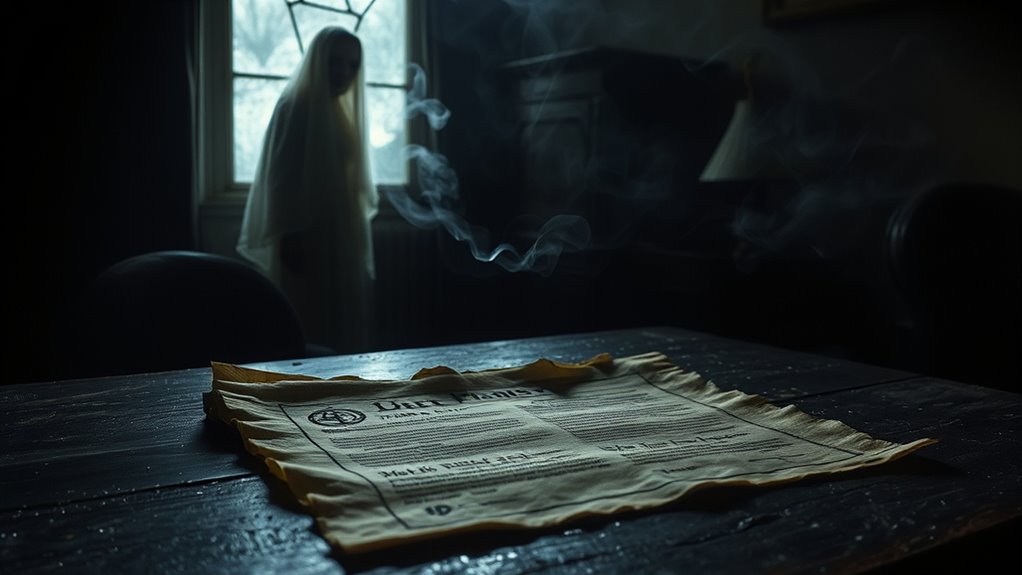
While tales of hauntings and curses have long captivated audiences, their impact in popular culture is particularly profound.
You see, haunted environments, like those in Shirley Jackson’s “The Haunting of Hill House,” illustrate how unresolved trauma affects individuals. On the flip side, cursed objects, such as the infamous Dybbuk Box, fuel urban legends and inspire modern horror narratives.
Media representations, from movies to shows like “American Horror Story,” intertwine hauntings and curses, showcasing their psychological and supernatural effects. These stories reflect societal fears, with hauntings symbolizing unresolved issues and curses embodying the anxiety of misfortune.
Media portrayals of hauntings and curses reveal deep-seated fears, merging psychological struggles with supernatural terror.
Museums, like Zak Bagans’ The Haunted Museum, even commodify these cursed objects, drawing curious visitors enthusiastic to explore their potential dangers.
Frequently Asked Questions
What’s the Difference Between Haunted and Cursed?
When you think about haunted versus cursed, it’s all about the source of the negativity.
Haunted places or objects are inhabited by spirits, often tied to their past, but they can return to normal once those spirits are dealt with.
Cursed items, on the other hand, carry an inherent evil, causing misfortune or harm regardless of any spiritual presence.
What Counts as a Curse?
A curse is like a shadow that clings to you, whispering misfortune in your ear. It’s an intentional hex or spell cast upon a person or object, meant to bring harm or bad luck.
You might find cursed items steeped in tragic tales, their dark histories echoing through time. When you own something cursed, you might feel that weight, as if the universe conspired to turn your fortunes upside down.
What Is an Example of Haunting?
An example of a haunting can be found in Shirley Jackson’s “The Haunting of Hill House.”
You’ll notice how the house itself distorts reality and affects its inhabitants’ minds. As you read, you can feel the eerie atmosphere and the psychological influence on the characters.
They encounter ghostly manifestations that reveal their unresolved traumas, creating an emotional impact that lingers throughout the story.
Hauntings like this intertwine the living with the spirits of the past.
What Is the Biblical Definition of Curse?
Imagine planting a garden, only to find the soil cursed, refusing to yield fruit.
In the Bible, a curse is a pronouncement of harm or misfortune, often tied to divine disfavor due to disobedience.
For instance, Adam and Eve faced a curse after eating the forbidden fruit.
Curses can serve as consequences for sin, emphasizing the importance of following God’s commandments and the serious nature of breaking His covenant.
Conclusion
So, whether you’re dodging the ghostly whispers of a haunted house or tiptoeing around a cursed object like it’s a live grenade, remember: it’s all in good fun! Who needs therapy when you can have a supernatural entity crashing your dinner party? Just think of it as an eccentric roommate with a flair for the dramatic. Next time you hear a creak or find a cursed doll staring at you, smile—after all, it’s just another day in the paranormal neighborhood!



